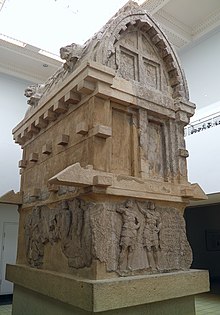 Upper part of Payava's tomb in the British Museum | |
 | |
| Location | Originally Xanthos, Lycia, Persian Empire (modern-day Kınık, Kaş, Turkey; now British Museum, Room 20 |
|---|---|
| Type | Barrel-vaulted sarcophagus |
| Material | Stone |
| Height | 3.5 metres (11 ft), originally 7.85 metres (25.8 ft)[1] |
| Completion date | 375-360 BC |
The Tomb of Payava is a Lycian tall rectangular free-standing barrel-vaulted stone sarcophagus, and one of the most famous tombs of Xanthos. It was built in the Achaemenid Persian Empire,[2] for Payava, who was probably the ruler of Xanthos, Lycia (modern-day Kınık, Kaş, Turkey) at the time, in around 360 BC. The tomb was discovered in 1838 and brought to England in 1844 by the explorer Sir Charles Fellows. He described it as a 'Gothic-formed Horse Tomb'.[3] According to Melanie Michailidis, though bearing a "Greek appearance", the Tomb of Payava, the Harpy Tomb and the Nereid Monument were built according to the main Zoroastrian criteria "by being composed of thick stone, raised on plinths off the ground, and having single windowless chambers".[4]
- ^ Jenkins, Ian (2006). Greek architecture and its sculpture. Harvard University Press. pp. 179–181. ISBN 0-674-02388-9.
- ^ Dusinberre 2013, p. 196.
- ^ "The tomb of Payava, a Lykian aristocrat". British Museum. Archived from the original on May 11, 2016. Retrieved 10 January 2016.
- ^ Michailidis 2009, p. 253.
